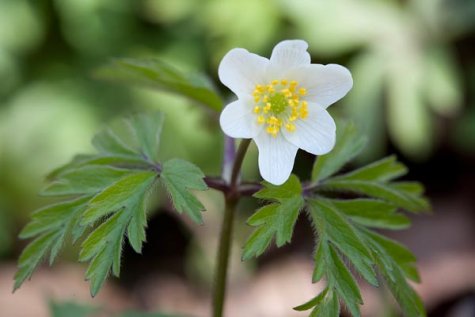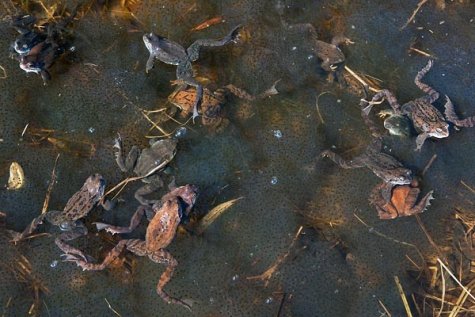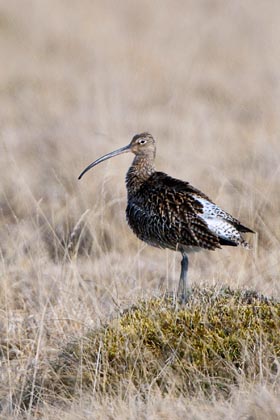Fourth week of April: play, play, play!
The four spring signs of the week:
Frog spawn,
Swallows bringing warm days,
Eyes of flowering violets and
Dusty and squishy fields.
No lock and no door can keep anybody indoors any longer, and the birdsong reaches in through the windows. A starling pair has diligently started to stuff the air intake under our window, accompanied by loud whistlings from five or six other spangled-coated companions – one let out such a very good oriole call, so that I had to look out to search for this yellow-feathered bird. The cuckoo has arrived in Pärnumaa, but has not been heard yet. And the swallows came with the warm days over the weekend everywhere in Estonia. The thrush has four eggs in the nest. In the white-tailed eagle webcam the devotion that Sulev and Linda spend on feeding and caring for their young is fantastic to see. The lesser spotted eagles already have an egg, and on Wednesday a … mole … was delivered to the nest!
The flowering period of willows has now reached us here in eastern Estonia too, or at least the bees return to the hive with yellow buttocks. The white blankets of wood anemones have little by little come to Mid-Estonia. Forest man Vello Keppart writes: “Last Tuesday the first wood anemone flowers were open in a warm corner in Luua park. The buds of currants and bird-cherries will soon be mouse-ear sized, and the gooseberries already have mouse ears. Elms and white elms (Ulmus laevis) started their flowering with the warm weather at the weekend.“ At Häädemeeste the marsh marigold flowers will soon be out, and in the warm shelter of Sagadi Castle there will be the first violets. Fields … well, many fields can’t take a tractor yet, but just nearby, in a higher area, the "iron horse" kicks up a dust tail from the ploughing. Mikk Sarv says about the tasks in the fields that in earlier times people used to sow beans on May 1 – this is also a good day to get clear about things: “Come and help at the My Estonia Ideas workout, help us to find the “thinking bean” of Estonia!“
Elks and deer have suddenly disappeared to somewhere. Only a few lonely roamers move around, the elk mums are birthing at any moment now, and have pushed off their last-year’s young – some elk youngster is sure to be seen in town soon, sniffing the traffic signs. The hares’ dance is in full swing in the fields again, the long-ears have one continuous wedding feast. The bear cubs at the rehabilitation centre grow on, and as stepmother Kaja describes “Climb, roll, play happily, and bite … one of the cubbies gets at the others’ food all the time, and when he is told off teeth come in action – but after all, they are wild animals.” Last week an odd grouse cock also arrived at the rehab centre, for some reason he can’t stand on his legs.
Frogs on roads and frogs in waters. The ear-splitting frog choir is not to be heard yet, but the first spawn globes of the common frog are already there in smaller ponds, that were free from ice early. It seems that all the breams are moving away from Peipsi to rivers and water meadows to start their spawning – that is, if they manage to get through the fishermen’s gauntlet. And it seems that for catching roaches nothing more is needed than showing an earthworm to the fish. Aotäht has understood that her task is to spit on the worm before it goes into the water … then to run away in the next moment as the gleaming fish rises out of the water … And the square-winged osprey surveys it all.
The native parrots – the starlings – run through all that they have heard during the year from the birch top. If last year’s favourite sound for the Nigula starlings was cackling, then this year it is the trumpeting of cranes, but the piping of the wryneck is even more popular, according to Kaja Kübar. The whistlers of Vilusi however try to mimic the rattle of the flagpole rope, or the church bells of Mustvee church. What have you heard – or taught to the whistler?
The year before last I didn’t get to the sauna on the eve of First of May before twelve o’clock at night. And when I threw the first ladle of water on to the hearth there was such a loud whistling from it that I grabbed my things and ran for home. Mikk teased me that look, didn't even know to ask for new clothes – “one by one, one by one, little sister”. For witches one way to gather helpers is to call for them with loud whistling. You can get power by making things whistle, as with a wind whirligig or a whistling stone. Find a skimming stone, as angular as possible, and when you throw it in an open field, or along the road at a four-road crossing, there will be a splendid whistle.











